
views
Joining the Team and Writing Different Types of Articles
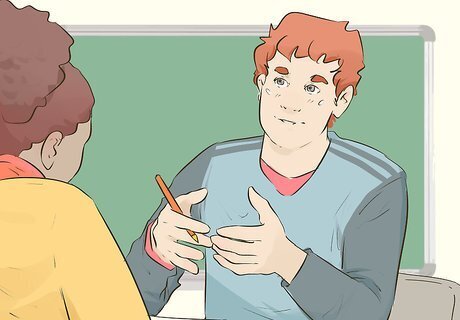
Audition to join the school newspaper team. If you aren't already on your school's newspaper staff, chances are you'll need to try out, or audition, to join the team. Most often, you'll need to submit several sample articles to prove that you have adequate writing and research skills. Check with the newspaper's staff supervisor to see what the process looks like for your school's newspaper. Check to see if there are deadlines for turning in mock articles, what the editor is looking for in a new staff member, and if there are any meetings you can attend to get more information.

Check with the editor to get an assignment. Once you're on the newspaper team, always check in with your editor to get specific assignments. If you have an idea for an article you'd like to write, pitch it to them and see if it's something you can get approval to work on. If you've been on staff for a while, you may have the freedom to choose your own article topics. But until you know your position, it's always a good idea to ask for assignments.
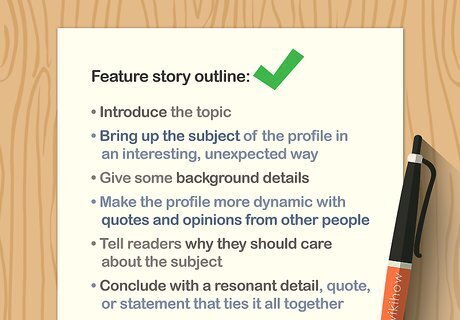
Write a feature story to explore an in-depth issue or event. Feature stories are generally 1000 words or more, and they focus on school policies, changes in the administration, national legislation that will affect the lives of students, and other big situations. When you write a feature story, focus on facts and research and include more background information than you would in other articles. Feature stories are the largest articles in a newspaper, and they often go beyond simple facts to the reasons behind something, like why an event happened and what it means for students moving forward. An example of a feature story would be an article about a new scholarship being offered in your state. How it works, who is eligible, and facts about the work that went into making the scholarship program a reality would make a compelling story.
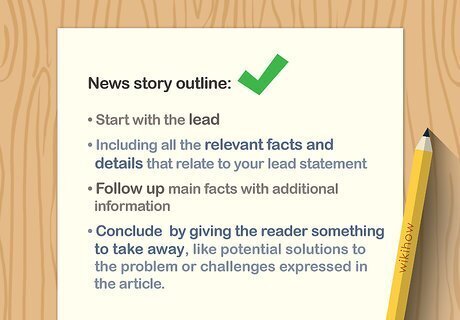
Work on a news story to share information about events or policies. A news story is generally a little shorter than a feature story, coming in at 750 to 1000 words. Write about information that students will find interesting or helpful, and focus on the facts of the story and offering multiple points of view about the situation. A news story should veer away from any personal feelings or opinions. News articles are generally more straight-forward than feature stories or opinion articles. They convey relevant information in an unbiased way.
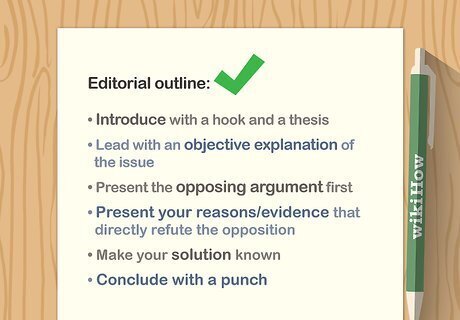
Submit an editorial if you'd like to write about general opinion. Editorials are also called “opinion pieces,” and they don't include a byline, meaning that your name won't be signed to the article. These pieces won't be written in the singular first-person point of view, they're about 500 words long, and they provide commentary on topical, relevant issues. For example, you could write an editorial about school rules, events or groups on campus, sports, programs, or teaching methods.
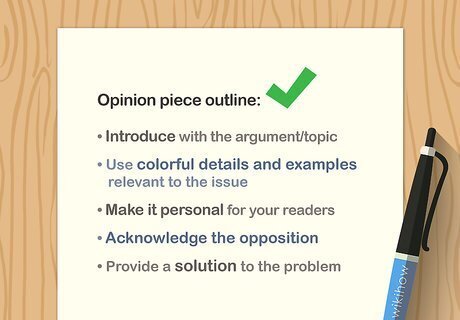
Choose to write a column to share your opinion and sign your name. Use the singular first-person when writing a column, and share your personal opinions about various topics. For example, you could write an advice column or a mental health column. Columns run anywhere from 250 to 750 words. If you want to be a regular columnist for your school newspaper, present a plan to your editor for a series of articles that you'd like to work on. For example, you could propose a 4-week series about starting a club or practicing self-care.

Share an educational article to teach others about a specific topic. How-to articles or other educational articles are fact- and action-oriented, and they can span many different topics. Make sure to write about topics that are interesting to students and school life to keep your articles engaging. For example, you could write an article called “Top 10 Tips to Manage Stress,” “How to Develop Good Study Habits,” or “How to Get in Shape before Tryouts.”
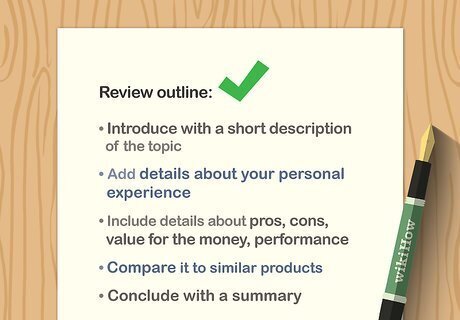
Publish reviews to share an objective opinion with readers. Review things like books, movies, classes, music, and TV shows. Include a brief description of the thing you're reviewing, and then write about a few objective positives and negatives to help others decide if they'd like to spend money or time on the presented subject. For example, if you review a new movie that came out, you could write about who would most enjoy the film. Perhaps it would be great for someone who likes action movies but not as enjoyable for someone who prefers comedies.
Researching, Interviewing, and Fact Gathering
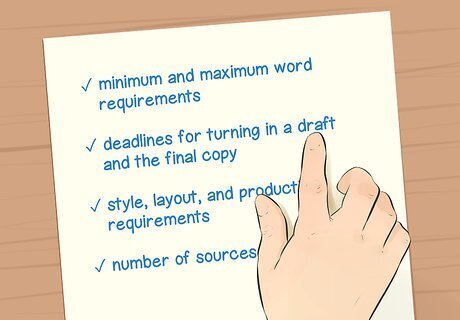
Check the submission guidelines before writing your article. You need to know the minimum and maximum word requirements, deadlines for turning in a draft and a final copy, and any other specifics about style, layout, and production. Some papers require a minimum number of sources for an article, or you may have to submit your piece to a fact-checker before it's approved for editing. Talk to your editor, production manager, or faculty advisor for more information.

Ask simple questions to gather the basic information for your article. Once you know what you're going to write about, start asking questions. Who, what, where, when, why, and how, are great basic questions to help you get the information you'll need to write a compelling article. Take notes on the answers to each of these questions, and let them lead you to other areas of inquiry. Who? Find out who was involved, whether that would be students, administrators, or other people in your community. What? Write down exactly what it is that you are writing about. Is it an event, a person, or an idea? Be as specific as possible. Where? Identify where the event took place. Is this a subject that is particular to your school or community, or is it a national subject? When? Make note of important dates and times. Why? Determine the reasons behind the subject. Was there a catalyst? How? Connect the rest of your information together to determine how an event or subject came together.

Interview good sources or witnesses to get quotes. Identify the people you need to talk to, and then contact them to set up interviews. Prepare questions ahead of time and bring a notebook or recorder with you so you can take notes. Try to hold the interview in a quiet location, like a coffee shop or empty classroom, so that it's easier for both you and your subject to concentrate. When contacting a person for an interview, let them know who you are and what topic you're writing about, and give them an estimate of how much of their time you'll need. When you finish an interview, take 10 minutes to write down additional notes right away. They'll be fresh in your mind and you'll be less likely to forget important details.

Talk with other students and teachers to get their opinions on the topic. If you're writing about a subject that affects your peers, get their input. Many articles include quotes from other people, so don't be afraid to take polls or get statements from others. Ask if you have someone's permission to use their name and words in your article, and write down their quote verbatim. You can use anonymous sources, but quotes are more compelling when they can be traced back to a specific individual.

Fact-check all the information you gather. Even if a reliable source tells you something, you still need to fact-check it if you can. Opinions, of course, can't be fact-checked. But if someone tells you names, dates, or details that can be verified through another source, take the time to do so. Fact-checking makes you a more trustworthy writer and ensures that you're taking the time to communicate as truthfully as you can about any particular subject.

Keep track of all your research and sources. Whether you use a notebook, files, or a computer to take notes, develop a consistent system for writing articles. Write down who said what, where you found a fact, and what dates things occurred on, even your interviews. This will help later if you need to back up a claim you made or if you need to verify information in your article. Some reporters dictate notes to themselves or write out daily logs about their interviews and research. Figure out what works for you and your lifestyle, and then stick to it.
Writing the Article
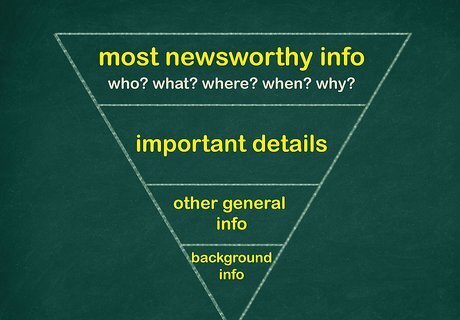
Use the inverted pyramid style to captivate readers. Include the most important details at the beginning of your article and let them take up the most space. Each subsequent paragraph can include general information and background notes, but put the most compelling information about the “who, what, where, when, why, and how” of the story first. A lot of times, readers will decide if they want to continue reading an article based off of the first sentence or two.

Come up with a catchy headline to hook people into reading your article. The headline, or “hed,” needs to be catchy while communicating the essence of the article with just a few words. Keep the headline short, direct, and active. Match the tone of the headline to the tone of the article. Sometimes you'll come up with a great headline before you even write the article, but most often you won't know exactly what you're presenting until after you've written it. Try waiting until after you've written your article to come up with the headline, and then make sure it fits in with the given topic.
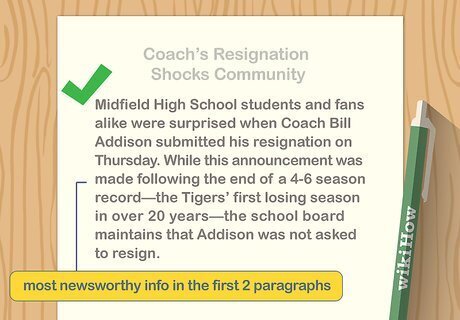
Answer all the pertinent questions within the first 2 paragraphs. Keep each paragraph to 3 or 4 sentences maximum. Present the information and give the details about the subject at hand. Save background information and quotes for the following paragraphs. People who want to know more about the topic will continue reading past those first 2 paragraphs, but people who just wanted the basic information will get their answers without having to search through the entire article.
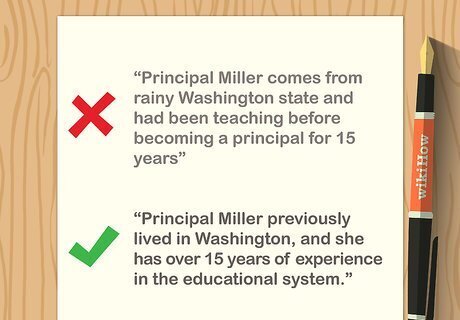
Write with clear, descriptive language and an engaging tone. Avoid flowery language or redundant sentences. Be specific and concise, and communicate why the subject matters. Use the active voice and an informational tone. For example, instead of saying, “Principal Miller comes from rainy Washington state and had been teaching before becoming a principal for 15 years,” you could say something like, “Principal Miller previously lived in Washington, and she has over 15 years of experience in the educational system."

Include quotations that support the content of the article. When you can, use a quote to communicate an opinion (unless you're writing a column) or a directive. For example, if the flu is spreading around school, get a quote from the school nurse about preventative measures students can take to stay healthy. Quotes should give your article authority and back up the facts you're presenting. Always ask for permission to quote someone when you're interviewing them.
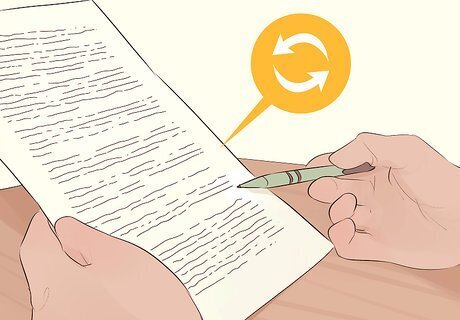
Proofread and edit your article before submitting it to your editor. Check that your sources are cited correctly and proofread for grammatical and spelling errors. Read your article out loud to listen for awkward sentences or poorly constructed paragraphs. You could even have a friend or peer review your article to see if there are any details you forgot to include. Being able to proofread your own work is an essential part of being a successful member of the newspaper staff, and the more you work at it, the better you'll get.



















Comments
0 comment